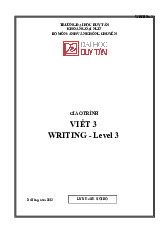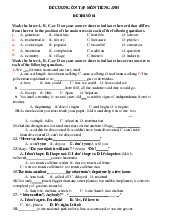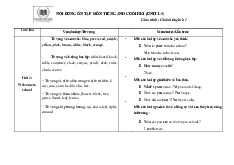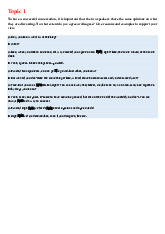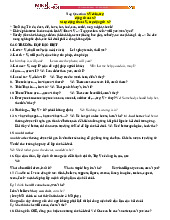




Preview text:
lOMoAR cPSD| 46836766
1. What does WISE in the WISE flow chart stand for?
WISE in the WISE flow chart stands for "Welcome, Introduction, Supporting Points, and Ending."
1 . In the WISE flow chart, "WISE" stands for :
W - Warm-up: Engage the audience and create a positive atmosphere.
I - Introduction: Provide an overview of the topic and establish your credibility.
S - Support: Present the main points or arguments with supporting evidence.
E - Example: Include relevant examples or anecdotes to enhance understanding.
2. Besides the main parts in the WISE flow chart, what other points should be included in the
introduction of a presentation?
In addition to the main parts of the WISE flow chart, the introduction of a presentation should include:
- Attention grabber: Start with a hook or an intriguing fact to capture the audience's interest.
- Purpose statement: Clearly state the objective or goal of your presentation.
- Agenda preview: Provide a brief overview of the main points or topics you will cover. -
Relevance statement: Explain why the topic is important or how it relates to the audience's interests or needs.
- Personal connection: Share a personal story or experience related to the topic to establish a connection with the audience.
3. Can you list four ways we can use to tell the audience what we are going to say?
Four ways to tell the audience what we are going to say are:
- Preview statements: Give a brief summary of the main points or topics you will address.
- Outline the structure: Provide an overview of the organization or structure of your presentation.
- Pose questions: Ask rhetorical questions that hint at the upcoming content.
- Use verbal cues: Introduce phrases and words that signal the upcoming information, such as
"Next," "First," "In this section," or "Moving on to."
4. Can you list four techniques to get the audience’s attention we can use to start our talk?
Four techniques to get the audience's attention and start a talk are:
- Start with a compelling story or anecdote that relates to the topic.
- Begin with a thought-provoking question that encourages audience participation.
- Use a surprising statistic or fact that creates curiosity.
- Begin with a powerful quote that relates to the subject matter.
5. Can you list two “signposting” phrases we can use to say what is coming?
Two "signposting" phrases we can use to indicate what is coming are:
- "Firstly," or "First and foremost," to introduce the first point or topic.
- "In addition," or "Furthermore," to signal the introduction of additional information or supporting points.
6. Can you list four “signposting” phrases we can use to move on to the next point? lOMoAR cPSD| 46836766
Four "signposting" phrases to transition to the next point are:
- "Moving on," or "Now let's turn to," to shift the focus to the next point.
- "Next," or "The second/main point I'd like to discuss is," to indicate the order of presentation. -
"Moreover," or "Additionally," to emphasize the connection and relevance of the subsequent point.
- "Finally," or "Last but not least," to introduce the concluding point or wrap up the presentation.
7. Can you list three “signposting” phrases we can use to indicate the end of a section?
Three "signposting" phrases to indicate the end of a section are:
- "In conclusion," to summarize the key points before moving on.
- "To wrap up," to signal that you are concluding a specific section.
- "Lastly," or "Finally," to indicate that you are reaching the end of a particular segment.
8 . Can you list four “signposting” phrases we can use to refer back?
Four "signposting" phrases to refer back are:
- "As mentioned earlier," to harken back to a point previously discussed.
- "As we saw before," to connect the current information to a previous topic.
- "Building on that," to link the current content to a point made earlier.
- "Recalling," or "To recap," to remind the audience of a previously mentioned idea.
9. Can you list two “signposting” phrases we can use to summarize a point?
Two "signposting" phrases to summarize a point are:
- "In summary," or "To summarize," to provide a concise overview of the key point.
- "The main takeaway is," or "The key idea here is," to highlight the main message or lesson from the point discussed.
10 . Can you list four ways to emphasize important points?
Four ways to emphasize important points are:
- Repetition: Reiterate the key information or phrase to reinforce its significance.
- Vocal emphasis: Use tone, volume, and pacing to highlight important words or phrases. -
Visual cues: Utilize visuals such as bold or italicized text, underline, or different colors to draw attention to crucial points.
- Pause: Pause before or after an important point to create emphasis and allow it to sink in.
11 . What are the normal steps of a conclusion?
The typical steps of a conclusion are:
- Summarize the main points: Briefly recap the key ideas or arguments presented in the presentation.
- Restate the thesis or main message: Reinforce the central theme or purpose of your talk.
- Provide closure: Offer a satisfying ending or final thought related to the topic. lOMoAR cPSD| 46836766
- Call to action or conclusion statement: Encourage the audience to take a specific action, leave
them with a thought-provoking question, or provide a final statement that leaves a lasting impression.
12 . What are some ways to signal the end of a presentation?
Some ways to signal the end of a presentation are:
- Express gratitude: Thank the audience for their attention, participation, or the opportunity to present.
- Use a closing statement: Craft a memorable sentence or phrase that wraps up the
presentation. - Provide a final thought or call to action: Leave the audience with a final message
or encourage them to take specific action related to the topic.
- End with a strong visual or audio element: Conclude with a powerful image, a meaningful
quote, or a thought-provoking audio clip.
13 . . Can you list some ways to summarize the main points?
Ways to summarize the main points include:
- Restating the key ideas or arguments using concise language.
- Organizing the main points into a cohesive summary, emphasizing their importance or relevance collectively.
- Providing a bullet-point list or condensed version of each main point.
- Highlighting the key takeaways or lessons learned from the presentation.
14 . What are some ways to recommend or suggest something?
Ways to recommend or suggest something include:
- Using phrases like "I recommend," "I suggest," or "I would advise." - Providing specific
reasons or benefits to support the recommendation.
- Presenting examples or evidence that demonstrate the positive outcomes of the recommendation.
- Inviting the audience to consider or try the suggestion by using phrases such as "Why not,"
"Give it a try," or "Consider implementing."
15 . What are some ways to invite quest
Ways to invite questions include:
- Ending the presentation by saying "I'd be happy to answer any questions you may have." -
Providing a designated question and answer session after the conclusion of the presentation. -
Encouraging audience participation by saying "Please feel free to ask any questions or share your thoughts."
- Opening the floor for discussion by saying "Let's open it up for questions now, who would like to start?" lOMoAR cPSD| 46836766
From 2008 to 2014, British parents' financial outlay for their children's athletic activities increased consistently, with
football having the highest participation rates. The average expenditure on sports increased from 20 pounds in 2008
to over 30 pounds in 2014. Football enrollment reached over 7.5 million participants in 2008, while swimming saw a
gradual increase to 2.5 million. Conversely, athletics displayed a fluctuating trajectory, initiating well below 2.5
million and reaching a zenith of 5 million participants in 2012, only to recede to just under 5 million in 2014.
The graph shows a significant increase in university graduates in Canada between 1992 and 2007, with females graduating
more than males. In 1992, under 100,000 women graduated, but this number gradually increased to 100,000 by 1995. From
1998 to 2007, the number reached nearly 150,000. In contrast, in 1992, only 70,000 men graduated, and from 2001 to 2007,
the number increased dramatically to around 100,000 men. The trend of university graduations reflects the growing number of women and men in Canada.
The graph shows Japan's population growth from 1950 to 2055, with an upward trend in the elderly
population. The population initially reached 84.1 million, but increased to 127.8 million in 2010. From
2010 to 2055, the population is predicted to drop sharply to 89.9 million, almost the same as 1950. The
ratio of people aged 65 and over in 1950 was 4.1 million, accounting for less than 5% of the total
population. Over the next 55 years, the older population increased significantly, reaching over 40% in
2055 , making up 36.5 million people. lOMoAR cPSD| 46836766
In 1999, a pie chart showed that the majority of tourists visited four attractive places in Britain: theme
parks, museums and galleries, historic houses and mountains, and wildlife parks and zoos. The majority
of visitors (38%) visited theme parks, with Blackpool pleasure beach being the most popular (47%).
The remaining attractions were Chessington World of Adventures and Legoland, Windsor, which
received only 10% of the total visitors. The chart highlights the importance of theme parks in attracting tourists to Britain.
The graph shows the waste generated by three companies from 2000 to 2015. Company A was the
most popular fabric before 2012, but company C replaced it and generated the highest amount of
waste. Companies A and B showed downward trends, while company C showed upward trends.
Company A had a peak of 12 in 2000, decreased to 8 in the final years, and Company B had the
smallest amount of waste. Company C had the highest amount of waste, increasing from under 3 to 11.
The bar graph shows the number of non-profitable working hours completed by humans in a week,
including gardening, household chores, and childcare. Both males and females without children are
doing jobs without receiving money to support their families. Women with three or more infants are the
highest number, working in the house and garden. The lowest number of married women is 30 years
old and doesn't have children. Men with wives are workers, and their families remain stable. Women
have the largest number of wives, and all three families experience difficulties in working activities.
